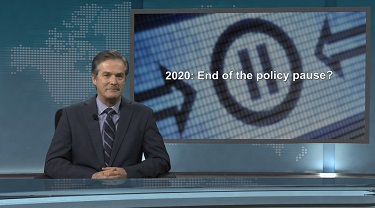The global trade policy pause that began in 2016 was the single most significant politico-economic event of the past 10 years. So, as we enter a new decade, will the pause persist, permanently constraining growth? Or will 2020 end this policy pause?
The closing days of 2019 gave cause for hope. The week of Dec. 9 was a big one: it saw significant movement on the United States-China trade impasse, with broad agreement on the Stage 1 deal that delayed tariff increases and brought symbolic tariff reductions. Further movements in negotiations over the holidays were even more positive. During the same week, Brexit experienced its first breakthrough since the 2016 referendum, with Boris Johnson’s Conservative party winning a commanding lead and a mandate to end the United Kingdom’s go/no-go dilemma. If these weren’t enough, the signing of the Canada-United States-Mexico Agreement (CUSMA) dialled down the uncertainty of North American trade’s future.
While the direction of movement is clearly positive, full resolution is hardly going to be a smooth ride. U.S. President Donald Trump intentionally uses surprise tactics to move deals forward, on more than just the trade front. Recent Mideast instability is a testament to that. And U.K. Prime Minister Boris Johnson seems to be backing away from his “die-in-the-ditch” pledge to secure resolution with the European Union this year—renewing uncertainty as to the timing of Brexit resolution. Thankfully, there’s no such wobbling on the North American trade front—let’s just hope it stays that way.
What matters critically in all of this is that business gets to a point where there’s more certainty about trade flows. That, in turn, will ease business fears about their global investment plans. We’re not there yet—and indeed, this isn’t something that’s easy to fix. Business investment happens on long horizons, and once scared away from particular ventures, it takes a lot of encouragement before business is ready to plunge in again. After all, shareholders are very unforgiving, and to many, the risks of bold international investment plays are currently too great.
It’ll also ease related fears about the organization of production. Supply chains are chains that don’t like getting rattled; they’re finely-crafted, internationally dispersed mechanisms designed to function in a just-in-time way, making reliability paramount. Disrupt these, and entire product lines suffer. Natural disasters have taught these chains a lot about how regionally vulnerable they can be. Trade policy upsets wreak the same supply-chain havoc, and what they’re looking for is some permanence to the ultimate order of all things trade.
Is it a pipe dream? Whether it is or not, most seem to think so. Day-to-day conversations with novice and expert alike are laced with laments about the uncertainty of the current order and the seemingly random decisions and tweets from key leaders. Amid the mayhem, it seems there’s a need to separate the means from the end. In this case, the means are confusion and intentional destabilization. The end? A “better” set of trade arrangements. Throughout the chaos, this has been the stated and/or implied end of the process. And with the progress seen on three key fronts, the end is becoming clearer.
Why is this all driving toward resolution? Simply put, it makes sense. The cost of unresolved trade impasses and the consequent tariffs, walls, taxes and other impediments is more of the same—to the point that cross-border costs become prohibitive. The trade and investment costs to the U.K. alone of a Brexit gone bad have been estimated at anywhere from 5% to 8% of U.K. GDP, in both cases a far larger hit than sustained in the Great Recession. Then there’s the impact of same on the EU. In the U.S.-China case, what’s ultimately at stake is the likelihood of a global recession. What is clear is that nobody wants that. Recessions cause internal instability and kill re-election plans, especially ones that are induced by policy decisions. It’s this logic that we believe will drive those with trade differences to imminent resolution. After all, slowdown means that time is running out.
The bottom line?
The EDC Economics team predicted there would be resolution to the world’s major trade disputes before the mid-point of 2020. So far, so good. It could be that the coming decade’s pivotal moment happens very early in the period. If so, it would make all the difference to the trajectory of the global economy, and general sentiments about the longer-term direction of world output.
This commentary is presented for informational purposes only. It’s not intended to be a comprehensive or detailed statement on any subject and no representations or warranties, express or implied, are made as to its accuracy, timeliness or completeness. Nothing in this commentary is intended to provide financial, legal, accounting or tax advice nor should it be relied upon. EDC nor the author is liable whatsoever for any loss or damage caused by, or resulting from, any use of or any inaccuracies, errors or omissions in the information provided.





